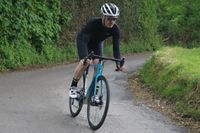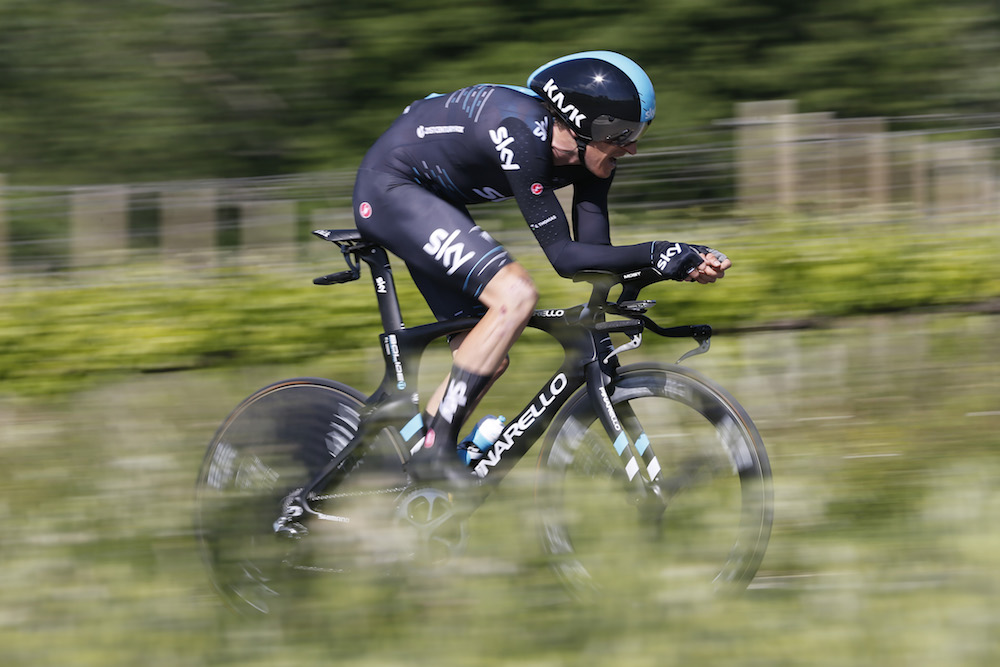Are aerodynamic fabrics worth it?
Simon Smythe and Paul Norman evaluate the real-world benefits of cutting-edge skinsuits that promise to cut drag to a minimum


Geraint Thomas and Mikel Landa of Team Sky debuted a brand new, secret skinsuit on stage 10 of the Giro d’Italia, which was noticeably different from the Castelli Bodypaint 3.3 suits worn by the rest of the team for the time trial.
Sky had been working with researchers from the Norwegian University of Science and Technology since 2016 and claimed to have taken a “completely new approach” to what has been done before; rethinking the fabric and way the suit is put together.
>>> Which aero bike is actually the fastest? (video)
Can some esoteric fabric really make that much of a difference or was this the latest example of Team Sky deploying psychological warfare?

Bioracer has supplied World Championship and Olympic-winning garments and is arguably the most experienced in the field.
“Bad fabrics will lose you a race, but you can’t always win with good ones,” says Sam Ratajczak, Bioracer’s development manager.
Different fabrics work better in different speed bands, Ratajczak explains. Bioracer, which has a long history of supplying world and Olympic champions, supplies three different materials.
The latest race content, interviews, features, reviews and expert buying guides, direct to your inbox!
There’s a fabric suited for speeds of 48-53kph (developed for top time triallists and road racers), another for speeds of 60-73kph (aimed at giving pro road sprinters the edge) and yet another for 38-45kph.
Watch: How much faster is an aero bike?
Bespoke ballistics
Not only are fabrics speed specific but they are also body-position specific. Xavier Disley of AeroCoach (aero-coach.co.uk), an aerodynamics testing service which also offers skinsuits designed with British company Nopinz, explains: “Different parts of the body have different requirements in terms of the way the airflow moves over them.
The airflow over your lower back is going to be entirely different from the airflow over your forearm or the front of your shoulder.
“With the Nopinz/AeroCoach Tripsuit we have a smoother fabric on the leading edge — the areas that face the airflow such as the front of the upper arm or the shoulder — since you have cleaner air.
"Then after the air starts moving around the body you get low-pressure eddies and the pressure gradient changes, so you want to have things like raised seams — ‘trips’ — or rougher fabrics in order to manipulate the airflow, to make it go where you want it to go.

"As soon as the airflow detaches from the body you have an area of low pressure and that area, like an eddy on a river behind a boat, is a source of drag that sucks you backwards. So you want to minimise that low-pressure wake behind the body.”
What sort of savings can a rider expect from a skinsuit made with correctly positioned seams and aero fabrics?
“We have a good comparison between the ‘flat’ skinsuit, the normal suit that Nopinz calls the Supersuit, and the Tripsuit that Nopinz makes,” says Disley.
“The Tripsuit is between six and 10 watts faster at 45kph. That equates to a saving of somewhere between 25 and 40 seconds over 40km.”
If Sky has developed a skinsuit that offers even greater savings than that, Chris Froome’s attempt to win a fourth Tour de France may have just got a little bit easier.
Expert take: Xavier Disley, AeroCoach
Do you need aerodynamic fabrics?
“For road riders, something like the Nopinz/AeroCoach Trip Jersey that we make is designed for the road position. If you have well-fitted bibshorts and one of our Trip Jerseys, it’s as quick as some skinsuits.
“If you don’t upgrade your current kit, just make sure it fits well, making sure you’ve pulled it down properly. Avoid baggy bits around the shoulders, which is quite common. That huge baggy section at the back of the neck and the tops of the shoulders — that’s not aerodynamic.
“If you go from a really terrible club skinsuit to a Nopinz/AeroCoach Tripsuit you can double the savings of 25-40 seconds over 40km [of the Tripsuit over the basic Nopinz skinsuit].
“Rather than buying a Cervélo P5 or whatever, making sure you’ve got the right skinsuit actually represents incredible value for money.
“Generally speaking, the biggest savings come from aerobars first; a good, well-fitting skinsuit and aero helmet second. Things like frames, wheels, tyres come after that.
"But if you’re coming from a flappy jersey and ill-fitting bibshorts then a good skinsuit could potentially save you as much as aerobars.”
Our take
Clearly the surface area of the body is much greater than that of the bike or the wheels, so garments that improve airflow over your body could not only save you watts but also thousands of pounds.
Even the most sophisticated, custom-fitted pro-level skinsuit is many times cheaper than a new aerodynamic bike.
Paul started writing for Cycling Weekly in 2015, covering cycling tech, new bikes and product testing. Since then, he’s reviewed hundreds of bikes and thousands of other pieces of cycling equipment for the magazine and the Cycling Weekly website.
He’s been cycling for a lot longer than that though and his travels by bike have taken him all around Europe and to California. He’s been riding gravel since before gravel bikes existed too, riding a cyclocross bike through the Chilterns and along the South Downs.
